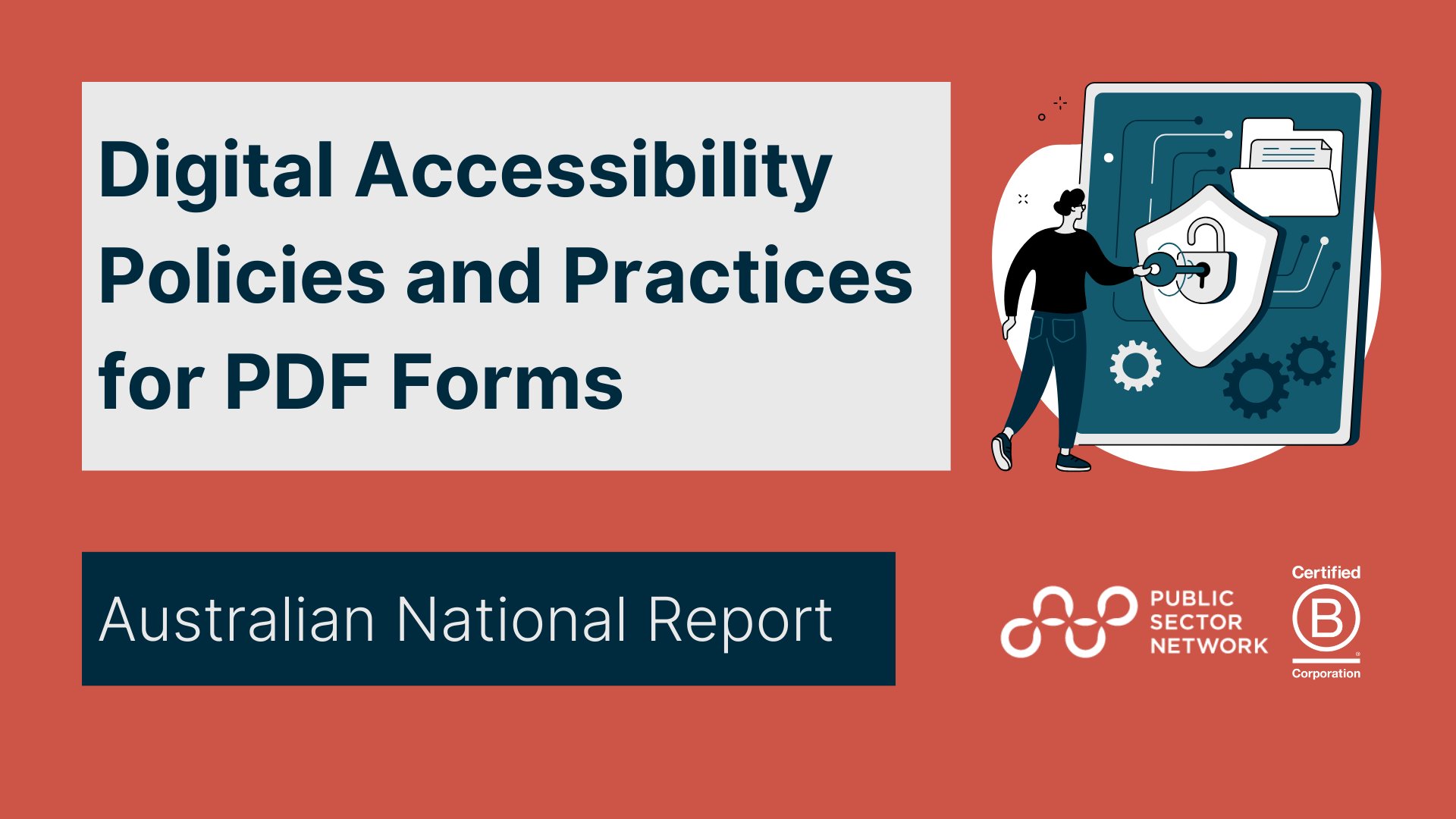

Introduction
This report provides a thorough examination of digital accessibility practices across Australian federal and state governments, with a specific focus on PDF forms. As the public sector increasingly aims to deliver inclusive digital services, PDF forms present unique challenges, particularly for individuals relying on assistive technologies. Unlike adaptable, web-native formats such as HTML, PDF forms often lack the flexibility needed to meet the diverse accessibility standards set forth by the Australian Government.
Using guidelines like the Digital Inclusion Standard and the Australian Government Style Manual as a foundation, this report analyses accessibility policies at both the federal and state levels. The goal is to identify commonalities and differences in how each jurisdiction addresses PDF form accessibility, highlighting where HTML forms are preferred for their compatibility with assistive technology. Across Australia, a shift is underway as government entities progressively favour HTML-based forms over static PDFs, recognising HTML’s inherent benefits in adaptability, usability, and compliance with WCAG 2.1 standards.
Through this national comparison, the report seeks to inform government decision-makers of the barriers associated with PDF forms, underscore the advantages of digital-first, accessible form formats, and provide recommendations for achieving more inclusive, user-centred government services.
1. Core Accessibility Requirements Across Policies for PDF Forms
Executive Summary: Australian federal and state governments consistently mandate WCAG 2.1 Level AA compliance, which influences the handling of PDF forms. While static PDF forms are recognised as accessible under specific criteria, they are generally viewed as secondary to HTML-based forms due to accessibility limitations. This reflects a growing understanding of the challenges inherent to PDF forms, and federal policies further reinforce the importance of prioritising adaptable, accessible formats.
The review reveals that all Australian states, along with the federal government, mandate compliance with WCAG 2.1 Level AA as a minimum standard, demonstrating a commitment to accessible digital content, including forms. This compliance is integral to addressing the accessibility issues inherent in static formats like PDFs, which frequently fail to fully meet WCAG standards due to limited adaptability and integration challenges with assistive technologies.
At the federal level, the Digital Inclusion Standard reinforces this commitment by requiring accessibility across all government digital forms, in line with obligations under the Disability Discrimination Act 1992. This federal emphasis provides a unified framework for states, although each jurisdiction exhibits unique responses to the limitations of PDF forms, such as Tasmania’s ambition for AAA compliance in some cases.
While these standards represent a unified approach to accessibility, they also underscore a shared recognition that static formats like PDFs can hinder accessibility. The prioritisation of HTML over PDFs, as seen in both state and federal guidelines, reflects an understanding that PDF forms often require additional resources for accessibility compliance, while HTML-based forms inherently offer better support for diverse user needs.
Jurisdiction | WCAG Compliance | General Accessibility Focus for Forms |
Federal | WCAG 2.1 Level AA | Digital Inclusion Standard mandates accessibility across federal digital content, reinforcing the shift away from PDF forms where possible. |
NSW | WCAG 2.1 Level AA | Strong preference for HTML forms over PDFs, positioning HTML as a more accessible choice. |
Victoria | WCAG 2.1 Level AA | Encourages alternatives to PDF forms, requiring accessible digital services for diverse needs. |
Queensland | WCAG 2.1 Level AA | Emphasises digital accessibility plans to reduce reliance on PDF forms and promote HTML. |
South Australia | WCAG 2.1 Level AA | Inclusion of accessible forms in user testing; advocates for regular audits on form usability. |
Northern Territory | WCAG compliance for all digital content | Prioritises accessible, device-compatible form design, discouraging PDF reliance. |
Tasmania | WCAG 2.1 Level AA (some AAA content) | Provides alternative formats for forms if PDFs cannot meet accessibility needs, promoting compatibility. |
2. PDF Accessibility Requirements Across Jurisdictions
Executive Summary: There is a clear and growing preference for HTML-based forms, with federal and state guidelines consistently discouraging PDF forms due to accessibility barriers. PDF forms are generally permitted only when absolutely necessary, reflecting a broad understanding that PDF forms lack the inherent flexibility required for full accessibility.
The approach to PDF forms varies across jurisdictions, but a clear trend emerges: states like NSW, Victoria, and Queensland actively discourage PDF forms, preferring HTML forms for accessibility and ease of use. South Australia, Northern Territory, and Tasmania show flexibility in allowing PDF forms, but emphasise alternative formats and accessible design to mitigate usability issues.
Federal guidance aligns with this trend, as outlined in the Australian Government Style Manual, which advises against PDF forms as a primary format. The Style Manual underscores that PDFs present numerous barriers to accessibility—especially in forms—due to challenges with tagging, navigation, and assistive technology compatibility. Federal recommendations advocate for web-native formats as a standard for forms, positioning PDF forms as a less preferable option that should be used only when absolutely necessary and supplemented with accessibility features.
Jurisdiction | Approach to PDF Forms | PDF Accessibility Emphasis |
Federal | Strongly discourages PDF forms, recommending HTML alternatives | Provides detailed guidelines for accessible PDFs only when absolutely necessary, due to tagging and usability limitations. |
NSW | Strongly discourages PDFs for forms, prioritising HTML | Notes that PDF forms create significant barriers for screen reader compatibility and navigation. |
Victoria | Recommends digital-first forms; PDF forms allowed only with accessible alternatives | Highlights accessibility gaps in PDF forms, recommending HTML as the primary format for adaptability. |
Queensland | Advises HTML for forms; allows PDFs with rigorous testing requirements | Stipulates that PDF forms must be thoroughly tested for compatibility with assistive technologies. |
South Australia | Minimal reference to PDF forms, strong preference for HTML | Emphasises a web-first approach for accessible forms, implicitly discouraging PDF forms. |
Northern Territory | Suggests HTML for short forms; PDF forms permissible for complex documents with accessibility features | Limits use of PDF forms, favouring web-native options where feasible. |
Tasmania | Allows PDF forms with accessible alternatives as backup | Acknowledges limitations in accessibility with third-party PDF forms. |
3. Digital Transformation in PDF Form Design and Conversion
Executive Summary: Digital transformation strategies across Australia favour HTML-based forms, with a significant emphasis on replacing static PDF forms to improve accessibility. Federal policies further support this approach, advocating for HTML as the preferred form format, with limited allowances for PDFs in complex cases.
A shared goal of transitioning to HTML-based forms reflects the push for digital transformation across federal and state governments. NSW, Victoria, Queensland, and South Australia strongly advocate for HTML as the default format for forms, while Northern Territory and Tasmania support HTML as the preferred option but allow PDFs in limited cases for complex forms.
The Digital Inclusion Standard further strengthens this shift by prioritising HTML over PDFs at the federal level, urging agencies to create user-friendly, adaptable forms. This emphasis on HTML in form design underscores the broader digital transformation objective, encouraging the replacement of PDF forms with responsive, web-based alternatives that are easier to adapt to accessibility standards.
Jurisdiction | Digital Transformation in Form Design | Preferred Format for Forms |
Federal | Digital Inclusion Standard recommends HTML for forms to enhance accessibility and usability | HTML, limited PDF use for forms |
NSW | Advocates for full digital transformation, prioritising HTML for forms | HTML |
Victoria | Encourages digital-first form design with a phased reduction in PDF use | HTML |
Queensland | Emphasises digital accessibility in form design; recommends HTML | HTML |
South Australia | Strongly advises HTML for forms, supported by regular audits | HTML |
Northern Territory | Recommends HTML for forms under 5 pages; PDF forms allowed for specific needs | HTML as primary, with limited PDF form use for complex content |
Tasmania | Prioritises web-first form design, allowing PDFs only when HTML is not feasible | HTML, limited PDF forms |
4. Common Barriers and Gaps in PDF Form Accessibility
Executive Summary: Both state and federal policies emphasise the accessibility gaps in PDF forms, especially around compatibility with assistive technology. HTML is consistently presented as a more accessible alternative for forms, with PDF forms viewed as a last-resort format due to inherent limitations.
All states highlight the inherent accessibility limitations of PDF forms, particularly when it comes to compatibility with assistive technologies. PDF forms often fail to meet adaptive needs, posing barriers to users who rely on screen readers, magnification, and other assistive tools. NSW, Victoria, and Queensland are particularly clear about these issues, explicitly advising against PDF forms when web-native options like HTML are available.
The Australian Government Style Manual at the federal level acknowledges these limitations, providing guidelines for PDF forms only when absolutely necessary and recommending that accessible HTML alternatives be provided whenever possible. This reinforces the idea that PDF forms are inherently limited, especially in accessibility features like reflow, tagging, and navigation.
Jurisdiction | Assistive Technology Compatibility for Forms | Noted Accessibility Gaps in PDF Forms |
Federal | Supports HTML forms as more compatible with assistive tech; PDF forms seen as less adaptable | PDF forms present significant compatibility issues with assistive technologies |
NSW | Prioritises HTML for assistive tech compatibility, highlights PDF form barriers | PDF forms lack reflow, complex navigation, and flexibility |
Victoria | Recommends tools for form creators to evaluate accessibility gaps in PDFs | Limited flexibility and interactivity in PDF forms compared to HTML |
Queensland | Emphasises testing for assistive tech compliance in PDF forms | PDF forms lack adaptability needed for diverse user needs |
South Australia | Advocates for web-first design to accommodate all users | Minimal reference to PDFs, showing preference for HTML forms |
Northern Territory | Encourages accessible, responsive form design | Limited guidance on PDFs but implies preference for web-based forms |
Tasmania | Provides alternative formats when PDF forms fall short on accessibility | Acknowledges incomplete accessibility in third-party PDFs |
5. Conclusion
This analysis underscores a critical shift within Australia’s federal and state governments toward prioritising accessible, adaptable digital forms, with HTML emerging as the preferred format over static PDFs. While PDF forms have traditionally been used across government services, they present notable barriers to accessibility, particularly for users relying on assistive technologies. Both federal guidelines, as outlined in the Australian Government Style Manual and Digital Inclusion Standard, and state-level policies highlight the limitations of PDF forms in meeting comprehensive accessibility standards.
Our findings reveal a consistent trend: HTML-based forms are viewed as inherently more flexible, easier to integrate with assistive technologies, and better suited to the evolving expectations of a digital-first public sector. While states vary in their allowances for PDF forms, the collective preference for HTML reflects an understanding that accessible, user-centred digital experiences require more adaptable formats. This momentum aligns with global best practices, demonstrating Australia’s commitment to inclusive, responsive digital services.
The implications of this shift are significant for agencies across all levels of government. By embracing HTML and reducing reliance on PDF forms, agencies can create digital services that are not only accessible but also future-proof, adaptable to new technologies and diverse user needs. Transitioning to HTML for form design will position government services to meet both current accessibility standards and future user expectations, building a foundation for long-term digital inclusivity.
References
Australian Government. (n.d.). Digital Inclusion Standard: Criterion 4 – Make It Accessible. Retrieved from https://www.digital.gov.au/policy/digital-experience/digital-inclusion-standard/dis-criterion-4-make-it-accessible
Australian Government. (n.d.). Forms. Style Manual. Retrieved from https://www.stylemanual.gov.au/content-types/forms
Australian Government. (n.d.). PDF (Portable Document Format). Style Manual. Retrieved from https://www.stylemanual.gov.au/content-types/pdf-portable-document-format
New South Wales Government. (n.d.). Accessibility and Inclusivity Toolkit: PDFs. Digital NSW. Retrieved from https://www.digital.nsw.gov.au/delivery/accessibility-and-inclusivity-toolkit/communication/pdfs
New South Wales Government. (n.d.). Online Forms Design. Digital NSW. Retrieved from https://www.digital.nsw.gov.au/delivery/accessibility-and-inclusivity-toolkit/design/online-forms
Northern Territory Government. (n.d.). Website Standards. Digital Territory. Retrieved from https://digitalterritory.nt.gov.au/digital-government/strategies-and-guidance/policies-standards-and-guidance/website-standards
Queensland Government. (n.d.). Digital Accessibility in Queensland. For Government. Retrieved from https://www.forgov.qld.gov.au/service-delivery-and-community-support/design-public-services/digital-accessibility/digital-accessibility-in-queensland#:~=ICT%20accessibility%20standards%20and%20guidelines,-Web%20Content%20Accessibility&text=Queensland%20digital%20products%2C%20services%20and,apps)%20and%20digital%20content%20accessible%20and%20digital%20content%20accessible)
Queensland Government. (n.d.). Make Digital Services Accessible. For Government. Retrieved from https://www.forgov.qld.gov.au/information-and-communication-technology/qgea-policies-standards-and-guidelines/digital-service-standard/make-digital-services-accessible
South Australian Government. (n.d.). Accessibility Guidelines for Government Websites. Accessibility SA. Retrieved from https://www.accessibility.sa.gov.au/introduction/accessibility-guidelines#:~=Meeting%20government%20accessibility%20requirements,WCAG%202.1%20as%20a%20minimum
South Australian Government. (n.d.). Online Accessibility Policy. Accessibility SA. Retrieved from https://www.accessibility.sa.gov.au/policy/south-australian-government/online-accessibility-policy
Tasmanian Government. (n.d.). Accessibility Guidelines. Department of Premier and Cabinet. Retrieved from https://www.dpac.tas.gov.au/accessibility
Victorian Government. (n.d.). Design Forms. VIC Government. Retrieved from https://www.vic.gov.au/design-forms
Victorian Government. (n.d.). Digital Accessibility Requirements. VIC Government. Retrieved from https://www.vic.gov.au/digital-accessibility-requirements
Victorian Government. (n.d.). Make Content Accessible. VIC Government. Retrieved from https://www.vic.gov.au/make-content-accessible
Western Australian Government. (n.d.). Accessibility and Inclusivity Standard. WA Government. Retrieved from https://www.wa.gov.au/government/publications/accessibility-and-inclusivity-standard
World Wide Web Consortium (W3C). (2018). Web Content Accessibility Guidelines (WCAG) 2.1. Retrieved from https://www.w3.org/TR/WCAG21/

































